Leadership Management Techniques and Influence in Organizations
VerifiedAdded on 2023/04/25
|14
|4723
|281
AI Summary
This document compares the leadership management techniques used by Mathew Wilkinson and Shauna Davidson in their respective organizations. It analyzes how they gain power and influence, how they motivate their employees, and their self-destructive tendencies. The document also compares how each leader rewards their employees and how effective their reward systems are.
Contribute Materials
Your contribution can guide someone’s learning journey. Share your
documents today.
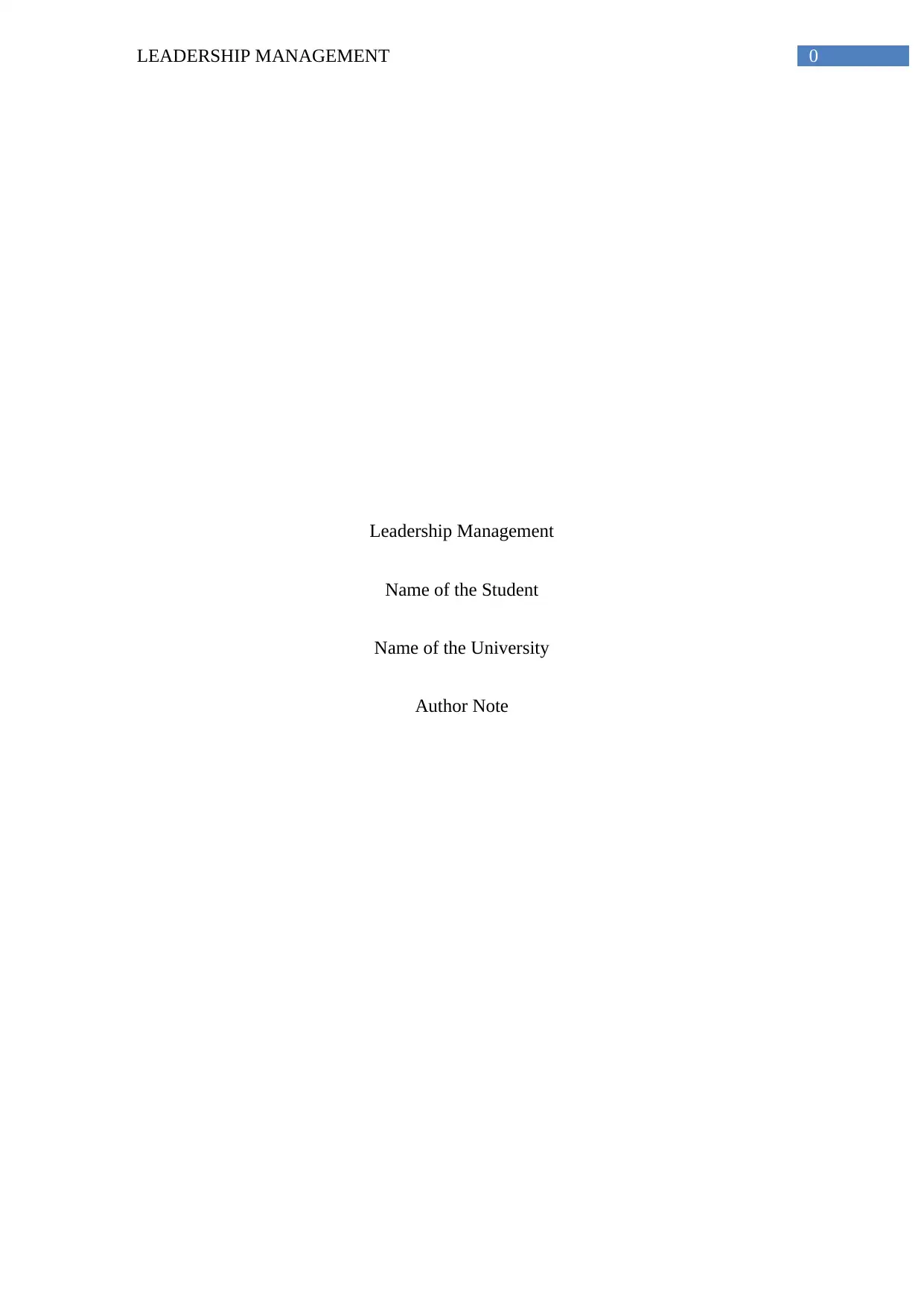
0LEADERSHIP MANAGEMENT
Leadership Management
Name of the Student
Name of the University
Author Note
Leadership Management
Name of the Student
Name of the University
Author Note
Secure Best Marks with AI Grader
Need help grading? Try our AI Grader for instant feedback on your assignments.
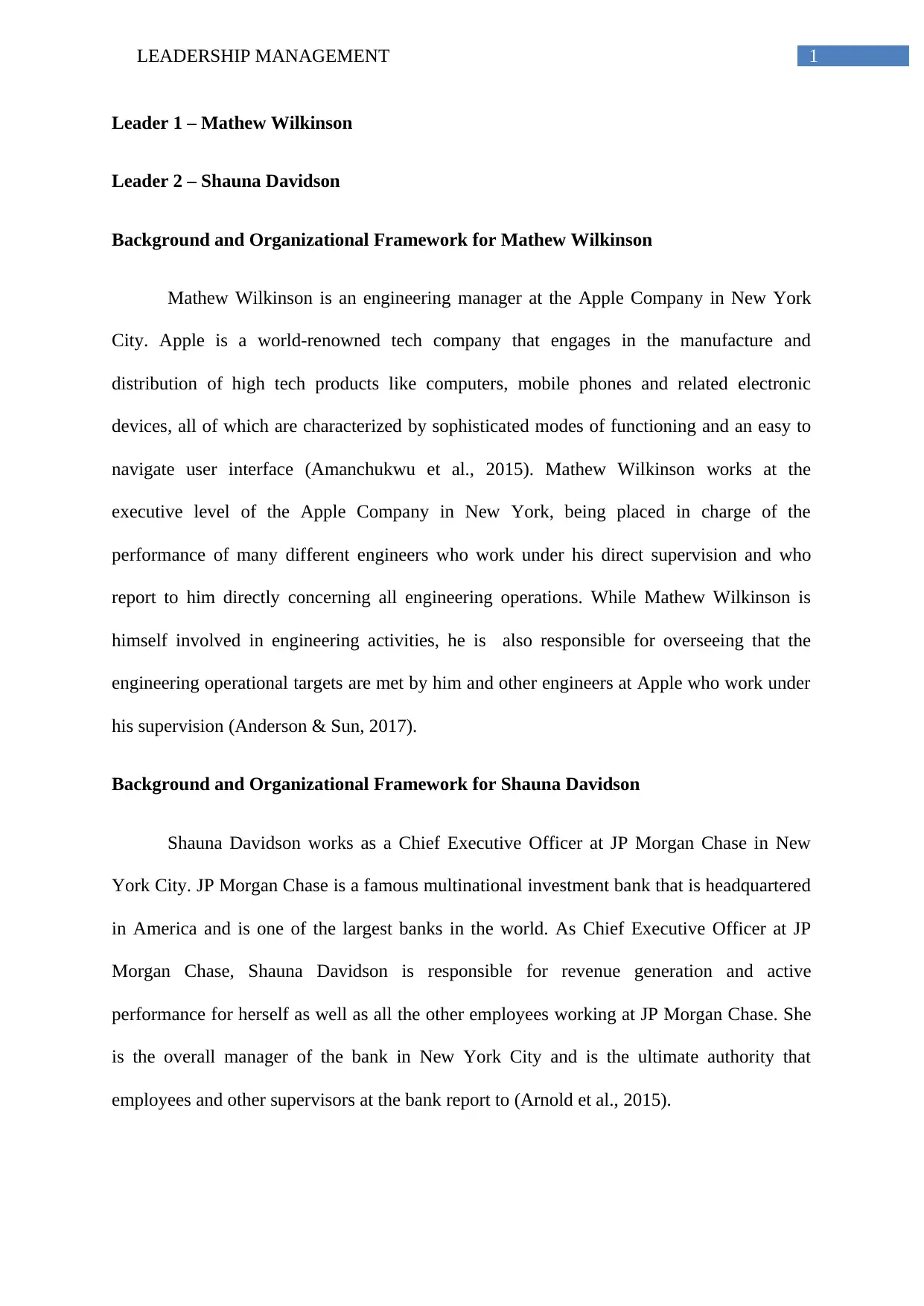
1LEADERSHIP MANAGEMENT
Leader 1 – Mathew Wilkinson
Leader 2 – Shauna Davidson
Background and Organizational Framework for Mathew Wilkinson
Mathew Wilkinson is an engineering manager at the Apple Company in New York
City. Apple is a world-renowned tech company that engages in the manufacture and
distribution of high tech products like computers, mobile phones and related electronic
devices, all of which are characterized by sophisticated modes of functioning and an easy to
navigate user interface (Amanchukwu et al., 2015). Mathew Wilkinson works at the
executive level of the Apple Company in New York, being placed in charge of the
performance of many different engineers who work under his direct supervision and who
report to him directly concerning all engineering operations. While Mathew Wilkinson is
himself involved in engineering activities, he is also responsible for overseeing that the
engineering operational targets are met by him and other engineers at Apple who work under
his supervision (Anderson & Sun, 2017).
Background and Organizational Framework for Shauna Davidson
Shauna Davidson works as a Chief Executive Officer at JP Morgan Chase in New
York City. JP Morgan Chase is a famous multinational investment bank that is headquartered
in America and is one of the largest banks in the world. As Chief Executive Officer at JP
Morgan Chase, Shauna Davidson is responsible for revenue generation and active
performance for herself as well as all the other employees working at JP Morgan Chase. She
is the overall manager of the bank in New York City and is the ultimate authority that
employees and other supervisors at the bank report to (Arnold et al., 2015).
Leader 1 – Mathew Wilkinson
Leader 2 – Shauna Davidson
Background and Organizational Framework for Mathew Wilkinson
Mathew Wilkinson is an engineering manager at the Apple Company in New York
City. Apple is a world-renowned tech company that engages in the manufacture and
distribution of high tech products like computers, mobile phones and related electronic
devices, all of which are characterized by sophisticated modes of functioning and an easy to
navigate user interface (Amanchukwu et al., 2015). Mathew Wilkinson works at the
executive level of the Apple Company in New York, being placed in charge of the
performance of many different engineers who work under his direct supervision and who
report to him directly concerning all engineering operations. While Mathew Wilkinson is
himself involved in engineering activities, he is also responsible for overseeing that the
engineering operational targets are met by him and other engineers at Apple who work under
his supervision (Anderson & Sun, 2017).
Background and Organizational Framework for Shauna Davidson
Shauna Davidson works as a Chief Executive Officer at JP Morgan Chase in New
York City. JP Morgan Chase is a famous multinational investment bank that is headquartered
in America and is one of the largest banks in the world. As Chief Executive Officer at JP
Morgan Chase, Shauna Davidson is responsible for revenue generation and active
performance for herself as well as all the other employees working at JP Morgan Chase. She
is the overall manager of the bank in New York City and is the ultimate authority that
employees and other supervisors at the bank report to (Arnold et al., 2015).
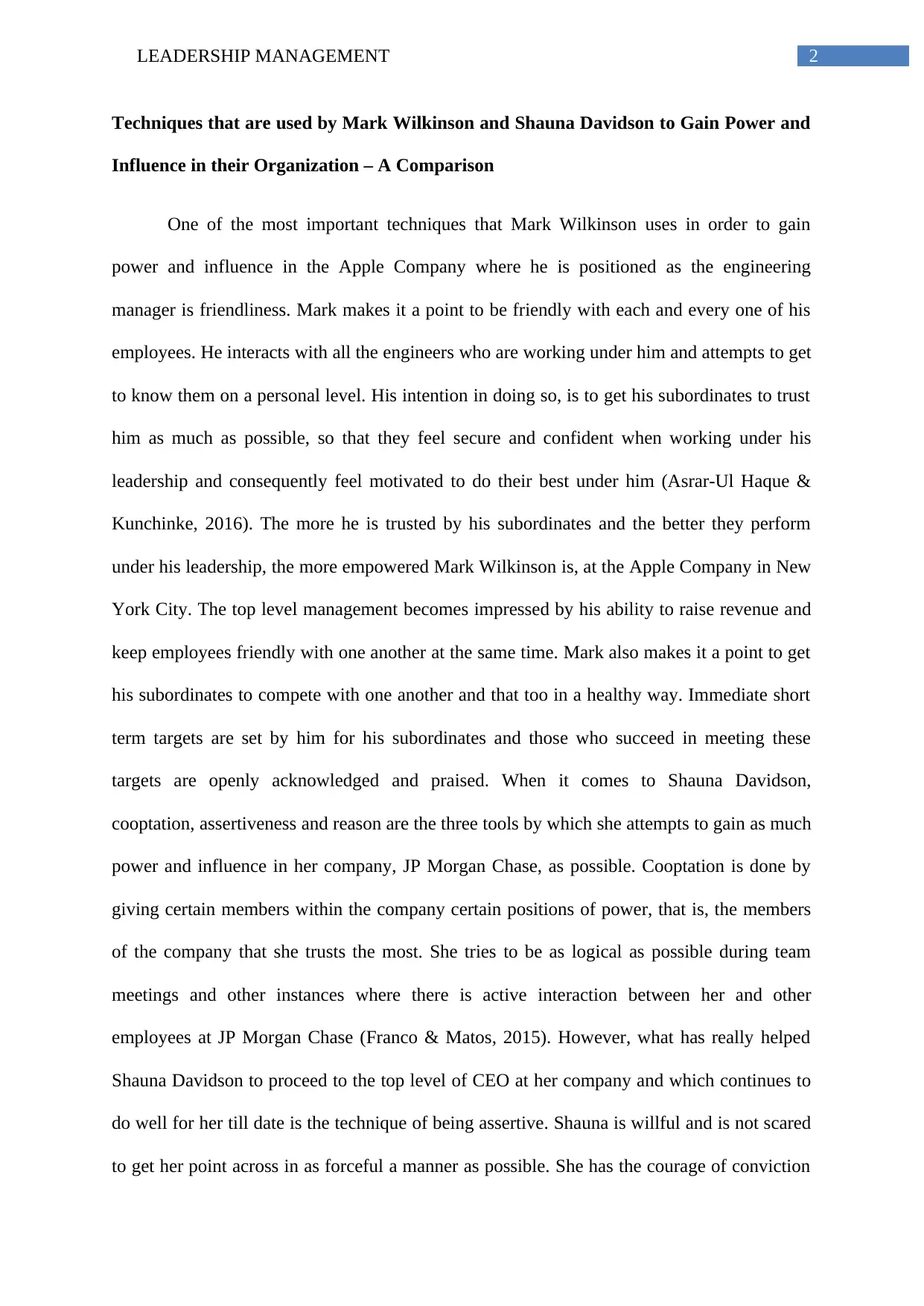
2LEADERSHIP MANAGEMENT
Techniques that are used by Mark Wilkinson and Shauna Davidson to Gain Power and
Influence in their Organization – A Comparison
One of the most important techniques that Mark Wilkinson uses in order to gain
power and influence in the Apple Company where he is positioned as the engineering
manager is friendliness. Mark makes it a point to be friendly with each and every one of his
employees. He interacts with all the engineers who are working under him and attempts to get
to know them on a personal level. His intention in doing so, is to get his subordinates to trust
him as much as possible, so that they feel secure and confident when working under his
leadership and consequently feel motivated to do their best under him (Asrar-Ul Haque &
Kunchinke, 2016). The more he is trusted by his subordinates and the better they perform
under his leadership, the more empowered Mark Wilkinson is, at the Apple Company in New
York City. The top level management becomes impressed by his ability to raise revenue and
keep employees friendly with one another at the same time. Mark also makes it a point to get
his subordinates to compete with one another and that too in a healthy way. Immediate short
term targets are set by him for his subordinates and those who succeed in meeting these
targets are openly acknowledged and praised. When it comes to Shauna Davidson,
cooptation, assertiveness and reason are the three tools by which she attempts to gain as much
power and influence in her company, JP Morgan Chase, as possible. Cooptation is done by
giving certain members within the company certain positions of power, that is, the members
of the company that she trusts the most. She tries to be as logical as possible during team
meetings and other instances where there is active interaction between her and other
employees at JP Morgan Chase (Franco & Matos, 2015). However, what has really helped
Shauna Davidson to proceed to the top level of CEO at her company and which continues to
do well for her till date is the technique of being assertive. Shauna is willful and is not scared
to get her point across in as forceful a manner as possible. She has the courage of conviction
Techniques that are used by Mark Wilkinson and Shauna Davidson to Gain Power and
Influence in their Organization – A Comparison
One of the most important techniques that Mark Wilkinson uses in order to gain
power and influence in the Apple Company where he is positioned as the engineering
manager is friendliness. Mark makes it a point to be friendly with each and every one of his
employees. He interacts with all the engineers who are working under him and attempts to get
to know them on a personal level. His intention in doing so, is to get his subordinates to trust
him as much as possible, so that they feel secure and confident when working under his
leadership and consequently feel motivated to do their best under him (Asrar-Ul Haque &
Kunchinke, 2016). The more he is trusted by his subordinates and the better they perform
under his leadership, the more empowered Mark Wilkinson is, at the Apple Company in New
York City. The top level management becomes impressed by his ability to raise revenue and
keep employees friendly with one another at the same time. Mark also makes it a point to get
his subordinates to compete with one another and that too in a healthy way. Immediate short
term targets are set by him for his subordinates and those who succeed in meeting these
targets are openly acknowledged and praised. When it comes to Shauna Davidson,
cooptation, assertiveness and reason are the three tools by which she attempts to gain as much
power and influence in her company, JP Morgan Chase, as possible. Cooptation is done by
giving certain members within the company certain positions of power, that is, the members
of the company that she trusts the most. She tries to be as logical as possible during team
meetings and other instances where there is active interaction between her and other
employees at JP Morgan Chase (Franco & Matos, 2015). However, what has really helped
Shauna Davidson to proceed to the top level of CEO at her company and which continues to
do well for her till date is the technique of being assertive. Shauna is willful and is not scared
to get her point across in as forceful a manner as possible. She has the courage of conviction
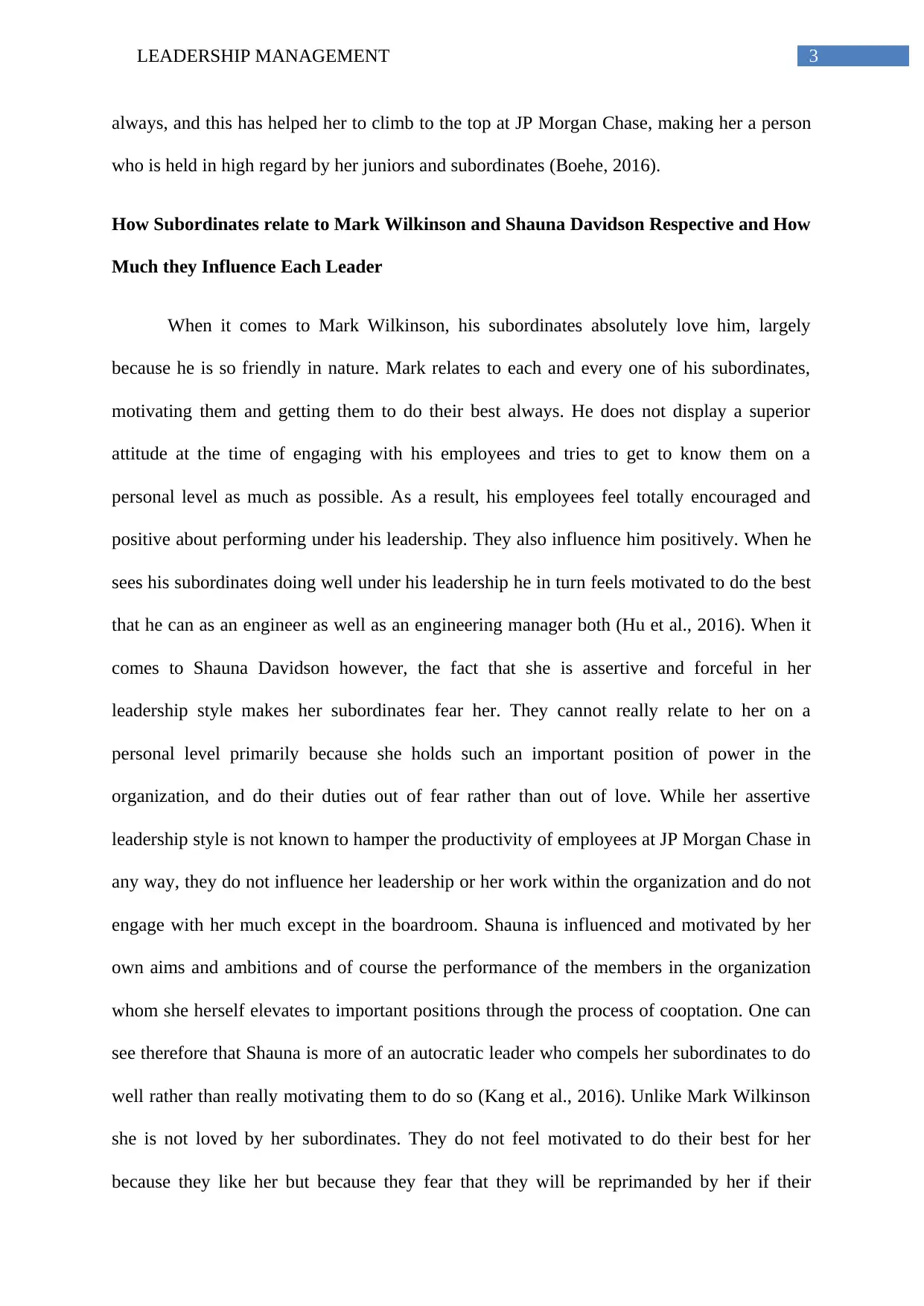
3LEADERSHIP MANAGEMENT
always, and this has helped her to climb to the top at JP Morgan Chase, making her a person
who is held in high regard by her juniors and subordinates (Boehe, 2016).
How Subordinates relate to Mark Wilkinson and Shauna Davidson Respective and How
Much they Influence Each Leader
When it comes to Mark Wilkinson, his subordinates absolutely love him, largely
because he is so friendly in nature. Mark relates to each and every one of his subordinates,
motivating them and getting them to do their best always. He does not display a superior
attitude at the time of engaging with his employees and tries to get to know them on a
personal level as much as possible. As a result, his employees feel totally encouraged and
positive about performing under his leadership. They also influence him positively. When he
sees his subordinates doing well under his leadership he in turn feels motivated to do the best
that he can as an engineer as well as an engineering manager both (Hu et al., 2016). When it
comes to Shauna Davidson however, the fact that she is assertive and forceful in her
leadership style makes her subordinates fear her. They cannot really relate to her on a
personal level primarily because she holds such an important position of power in the
organization, and do their duties out of fear rather than out of love. While her assertive
leadership style is not known to hamper the productivity of employees at JP Morgan Chase in
any way, they do not influence her leadership or her work within the organization and do not
engage with her much except in the boardroom. Shauna is influenced and motivated by her
own aims and ambitions and of course the performance of the members in the organization
whom she herself elevates to important positions through the process of cooptation. One can
see therefore that Shauna is more of an autocratic leader who compels her subordinates to do
well rather than really motivating them to do so (Kang et al., 2016). Unlike Mark Wilkinson
she is not loved by her subordinates. They do not feel motivated to do their best for her
because they like her but because they fear that they will be reprimanded by her if their
always, and this has helped her to climb to the top at JP Morgan Chase, making her a person
who is held in high regard by her juniors and subordinates (Boehe, 2016).
How Subordinates relate to Mark Wilkinson and Shauna Davidson Respective and How
Much they Influence Each Leader
When it comes to Mark Wilkinson, his subordinates absolutely love him, largely
because he is so friendly in nature. Mark relates to each and every one of his subordinates,
motivating them and getting them to do their best always. He does not display a superior
attitude at the time of engaging with his employees and tries to get to know them on a
personal level as much as possible. As a result, his employees feel totally encouraged and
positive about performing under his leadership. They also influence him positively. When he
sees his subordinates doing well under his leadership he in turn feels motivated to do the best
that he can as an engineer as well as an engineering manager both (Hu et al., 2016). When it
comes to Shauna Davidson however, the fact that she is assertive and forceful in her
leadership style makes her subordinates fear her. They cannot really relate to her on a
personal level primarily because she holds such an important position of power in the
organization, and do their duties out of fear rather than out of love. While her assertive
leadership style is not known to hamper the productivity of employees at JP Morgan Chase in
any way, they do not influence her leadership or her work within the organization and do not
engage with her much except in the boardroom. Shauna is influenced and motivated by her
own aims and ambitions and of course the performance of the members in the organization
whom she herself elevates to important positions through the process of cooptation. One can
see therefore that Shauna is more of an autocratic leader who compels her subordinates to do
well rather than really motivating them to do so (Kang et al., 2016). Unlike Mark Wilkinson
she is not loved by her subordinates. They do not feel motivated to do their best for her
because they like her but because they fear that they will be reprimanded by her if their
Secure Best Marks with AI Grader
Need help grading? Try our AI Grader for instant feedback on your assignments.
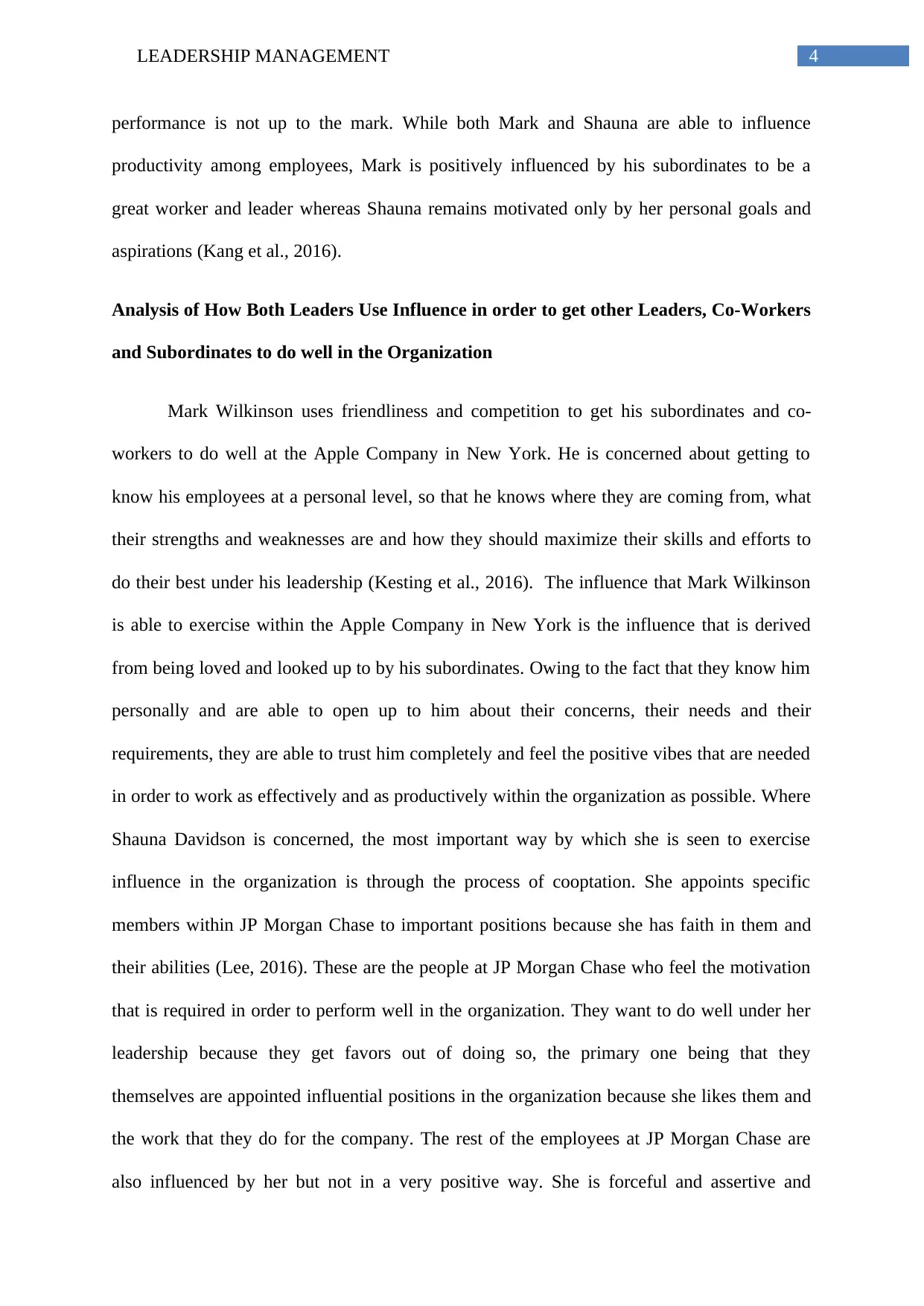
4LEADERSHIP MANAGEMENT
performance is not up to the mark. While both Mark and Shauna are able to influence
productivity among employees, Mark is positively influenced by his subordinates to be a
great worker and leader whereas Shauna remains motivated only by her personal goals and
aspirations (Kang et al., 2016).
Analysis of How Both Leaders Use Influence in order to get other Leaders, Co-Workers
and Subordinates to do well in the Organization
Mark Wilkinson uses friendliness and competition to get his subordinates and co-
workers to do well at the Apple Company in New York. He is concerned about getting to
know his employees at a personal level, so that he knows where they are coming from, what
their strengths and weaknesses are and how they should maximize their skills and efforts to
do their best under his leadership (Kesting et al., 2016). The influence that Mark Wilkinson
is able to exercise within the Apple Company in New York is the influence that is derived
from being loved and looked up to by his subordinates. Owing to the fact that they know him
personally and are able to open up to him about their concerns, their needs and their
requirements, they are able to trust him completely and feel the positive vibes that are needed
in order to work as effectively and as productively within the organization as possible. Where
Shauna Davidson is concerned, the most important way by which she is seen to exercise
influence in the organization is through the process of cooptation. She appoints specific
members within JP Morgan Chase to important positions because she has faith in them and
their abilities (Lee, 2016). These are the people at JP Morgan Chase who feel the motivation
that is required in order to perform well in the organization. They want to do well under her
leadership because they get favors out of doing so, the primary one being that they
themselves are appointed influential positions in the organization because she likes them and
the work that they do for the company. The rest of the employees at JP Morgan Chase are
also influenced by her but not in a very positive way. She is forceful and assertive and
performance is not up to the mark. While both Mark and Shauna are able to influence
productivity among employees, Mark is positively influenced by his subordinates to be a
great worker and leader whereas Shauna remains motivated only by her personal goals and
aspirations (Kang et al., 2016).
Analysis of How Both Leaders Use Influence in order to get other Leaders, Co-Workers
and Subordinates to do well in the Organization
Mark Wilkinson uses friendliness and competition to get his subordinates and co-
workers to do well at the Apple Company in New York. He is concerned about getting to
know his employees at a personal level, so that he knows where they are coming from, what
their strengths and weaknesses are and how they should maximize their skills and efforts to
do their best under his leadership (Kesting et al., 2016). The influence that Mark Wilkinson
is able to exercise within the Apple Company in New York is the influence that is derived
from being loved and looked up to by his subordinates. Owing to the fact that they know him
personally and are able to open up to him about their concerns, their needs and their
requirements, they are able to trust him completely and feel the positive vibes that are needed
in order to work as effectively and as productively within the organization as possible. Where
Shauna Davidson is concerned, the most important way by which she is seen to exercise
influence in the organization is through the process of cooptation. She appoints specific
members within JP Morgan Chase to important positions because she has faith in them and
their abilities (Lee, 2016). These are the people at JP Morgan Chase who feel the motivation
that is required in order to perform well in the organization. They want to do well under her
leadership because they get favors out of doing so, the primary one being that they
themselves are appointed influential positions in the organization because she likes them and
the work that they do for the company. The rest of the employees at JP Morgan Chase are
also influenced by her but not in a very positive way. She is forceful and assertive and
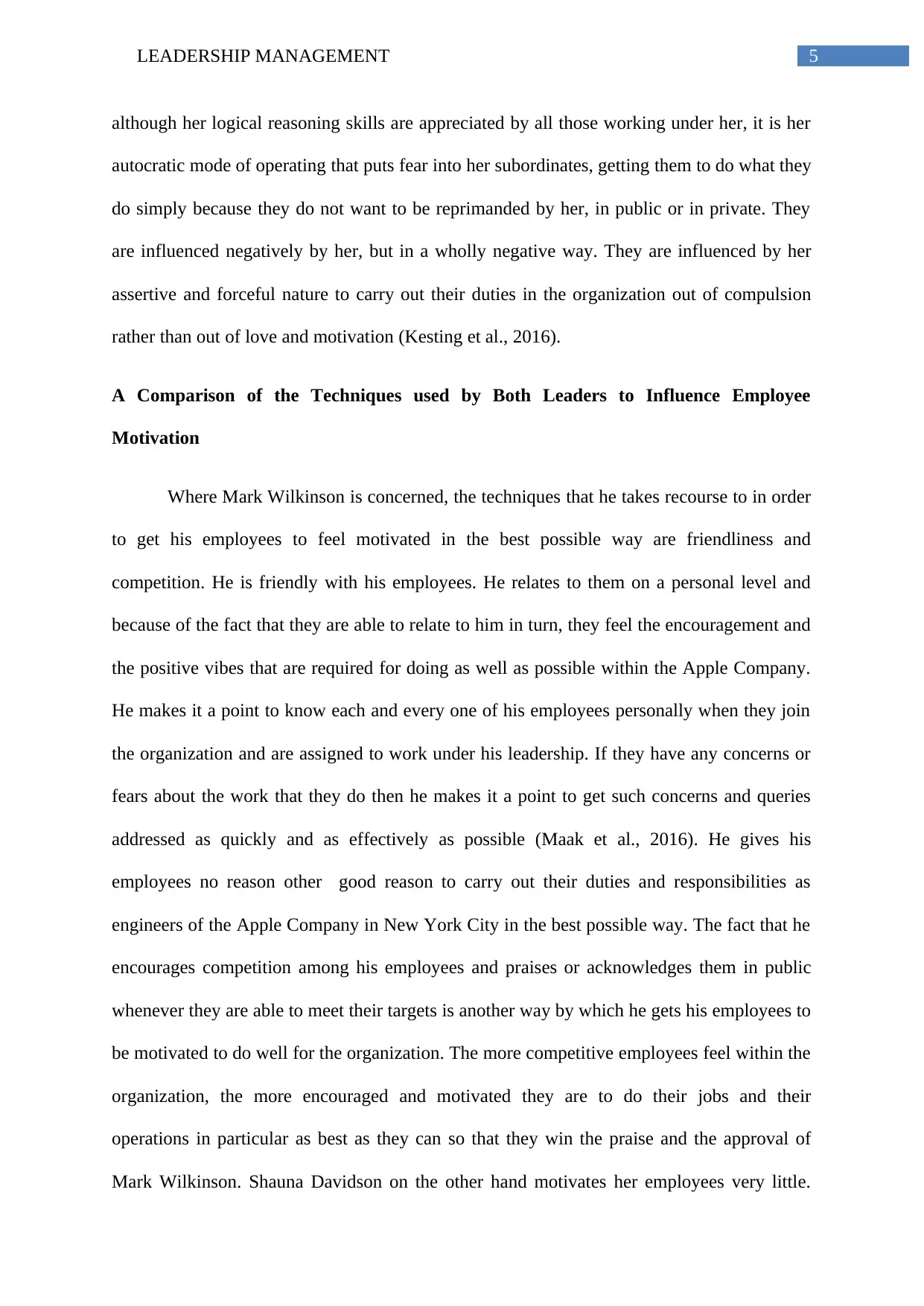
5LEADERSHIP MANAGEMENT
although her logical reasoning skills are appreciated by all those working under her, it is her
autocratic mode of operating that puts fear into her subordinates, getting them to do what they
do simply because they do not want to be reprimanded by her, in public or in private. They
are influenced negatively by her, but in a wholly negative way. They are influenced by her
assertive and forceful nature to carry out their duties in the organization out of compulsion
rather than out of love and motivation (Kesting et al., 2016).
A Comparison of the Techniques used by Both Leaders to Influence Employee
Motivation
Where Mark Wilkinson is concerned, the techniques that he takes recourse to in order
to get his employees to feel motivated in the best possible way are friendliness and
competition. He is friendly with his employees. He relates to them on a personal level and
because of the fact that they are able to relate to him in turn, they feel the encouragement and
the positive vibes that are required for doing as well as possible within the Apple Company.
He makes it a point to know each and every one of his employees personally when they join
the organization and are assigned to work under his leadership. If they have any concerns or
fears about the work that they do then he makes it a point to get such concerns and queries
addressed as quickly and as effectively as possible (Maak et al., 2016). He gives his
employees no reason other good reason to carry out their duties and responsibilities as
engineers of the Apple Company in New York City in the best possible way. The fact that he
encourages competition among his employees and praises or acknowledges them in public
whenever they are able to meet their targets is another way by which he gets his employees to
be motivated to do well for the organization. The more competitive employees feel within the
organization, the more encouraged and motivated they are to do their jobs and their
operations in particular as best as they can so that they win the praise and the approval of
Mark Wilkinson. Shauna Davidson on the other hand motivates her employees very little.
although her logical reasoning skills are appreciated by all those working under her, it is her
autocratic mode of operating that puts fear into her subordinates, getting them to do what they
do simply because they do not want to be reprimanded by her, in public or in private. They
are influenced negatively by her, but in a wholly negative way. They are influenced by her
assertive and forceful nature to carry out their duties in the organization out of compulsion
rather than out of love and motivation (Kesting et al., 2016).
A Comparison of the Techniques used by Both Leaders to Influence Employee
Motivation
Where Mark Wilkinson is concerned, the techniques that he takes recourse to in order
to get his employees to feel motivated in the best possible way are friendliness and
competition. He is friendly with his employees. He relates to them on a personal level and
because of the fact that they are able to relate to him in turn, they feel the encouragement and
the positive vibes that are required for doing as well as possible within the Apple Company.
He makes it a point to know each and every one of his employees personally when they join
the organization and are assigned to work under his leadership. If they have any concerns or
fears about the work that they do then he makes it a point to get such concerns and queries
addressed as quickly and as effectively as possible (Maak et al., 2016). He gives his
employees no reason other good reason to carry out their duties and responsibilities as
engineers of the Apple Company in New York City in the best possible way. The fact that he
encourages competition among his employees and praises or acknowledges them in public
whenever they are able to meet their targets is another way by which he gets his employees to
be motivated to do well for the organization. The more competitive employees feel within the
organization, the more encouraged and motivated they are to do their jobs and their
operations in particular as best as they can so that they win the praise and the approval of
Mark Wilkinson. Shauna Davidson on the other hand motivates her employees very little.
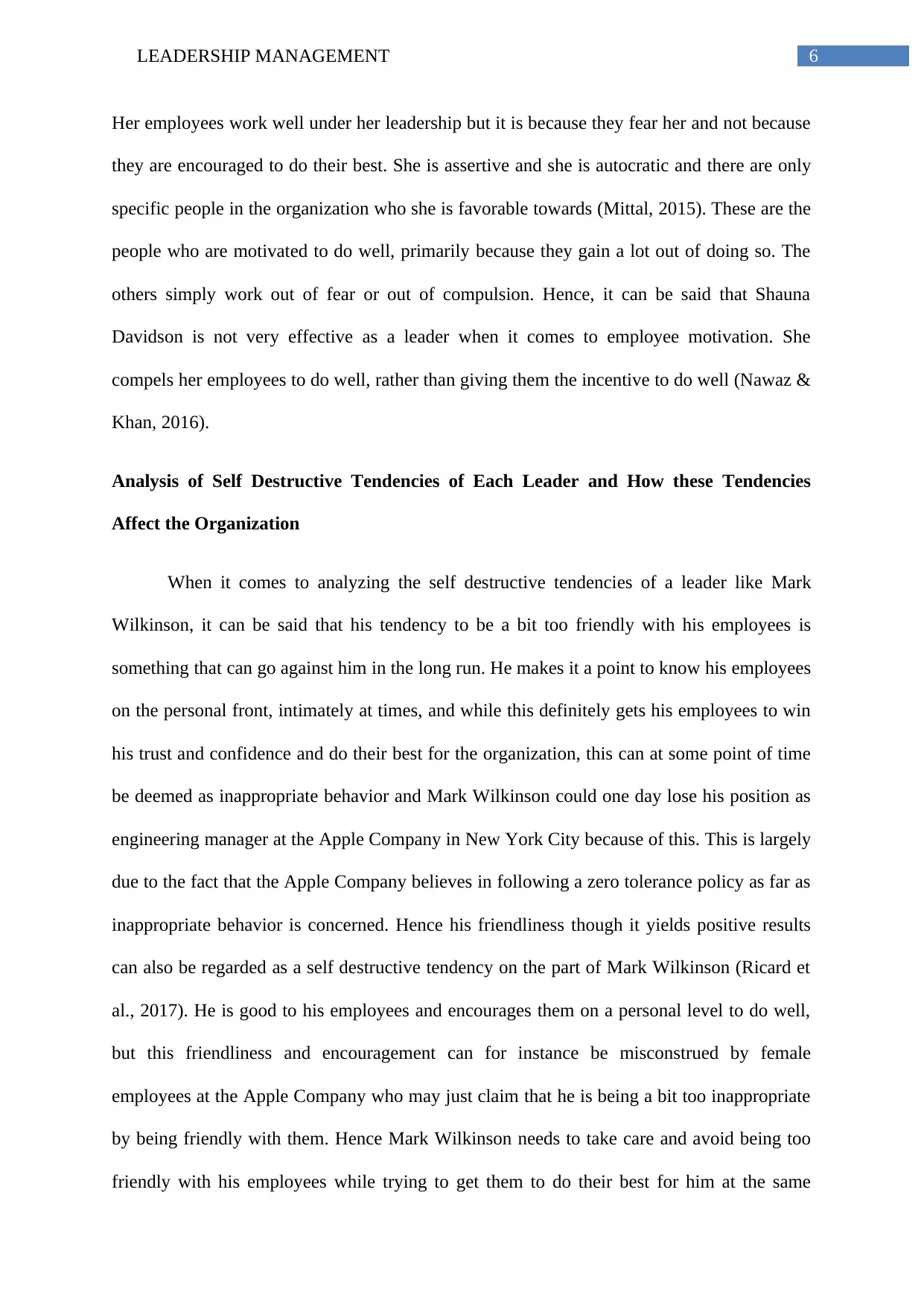
6LEADERSHIP MANAGEMENT
Her employees work well under her leadership but it is because they fear her and not because
they are encouraged to do their best. She is assertive and she is autocratic and there are only
specific people in the organization who she is favorable towards (Mittal, 2015). These are the
people who are motivated to do well, primarily because they gain a lot out of doing so. The
others simply work out of fear or out of compulsion. Hence, it can be said that Shauna
Davidson is not very effective as a leader when it comes to employee motivation. She
compels her employees to do well, rather than giving them the incentive to do well (Nawaz &
Khan, 2016).
Analysis of Self Destructive Tendencies of Each Leader and How these Tendencies
Affect the Organization
When it comes to analyzing the self destructive tendencies of a leader like Mark
Wilkinson, it can be said that his tendency to be a bit too friendly with his employees is
something that can go against him in the long run. He makes it a point to know his employees
on the personal front, intimately at times, and while this definitely gets his employees to win
his trust and confidence and do their best for the organization, this can at some point of time
be deemed as inappropriate behavior and Mark Wilkinson could one day lose his position as
engineering manager at the Apple Company in New York City because of this. This is largely
due to the fact that the Apple Company believes in following a zero tolerance policy as far as
inappropriate behavior is concerned. Hence his friendliness though it yields positive results
can also be regarded as a self destructive tendency on the part of Mark Wilkinson (Ricard et
al., 2017). He is good to his employees and encourages them on a personal level to do well,
but this friendliness and encouragement can for instance be misconstrued by female
employees at the Apple Company who may just claim that he is being a bit too inappropriate
by being friendly with them. Hence Mark Wilkinson needs to take care and avoid being too
friendly with his employees while trying to get them to do their best for him at the same
Her employees work well under her leadership but it is because they fear her and not because
they are encouraged to do their best. She is assertive and she is autocratic and there are only
specific people in the organization who she is favorable towards (Mittal, 2015). These are the
people who are motivated to do well, primarily because they gain a lot out of doing so. The
others simply work out of fear or out of compulsion. Hence, it can be said that Shauna
Davidson is not very effective as a leader when it comes to employee motivation. She
compels her employees to do well, rather than giving them the incentive to do well (Nawaz &
Khan, 2016).
Analysis of Self Destructive Tendencies of Each Leader and How these Tendencies
Affect the Organization
When it comes to analyzing the self destructive tendencies of a leader like Mark
Wilkinson, it can be said that his tendency to be a bit too friendly with his employees is
something that can go against him in the long run. He makes it a point to know his employees
on the personal front, intimately at times, and while this definitely gets his employees to win
his trust and confidence and do their best for the organization, this can at some point of time
be deemed as inappropriate behavior and Mark Wilkinson could one day lose his position as
engineering manager at the Apple Company in New York City because of this. This is largely
due to the fact that the Apple Company believes in following a zero tolerance policy as far as
inappropriate behavior is concerned. Hence his friendliness though it yields positive results
can also be regarded as a self destructive tendency on the part of Mark Wilkinson (Ricard et
al., 2017). He is good to his employees and encourages them on a personal level to do well,
but this friendliness and encouragement can for instance be misconstrued by female
employees at the Apple Company who may just claim that he is being a bit too inappropriate
by being friendly with them. Hence Mark Wilkinson needs to take care and avoid being too
friendly with his employees while trying to get them to do their best for him at the same
Paraphrase This Document
Need a fresh take? Get an instant paraphrase of this document with our AI Paraphraser
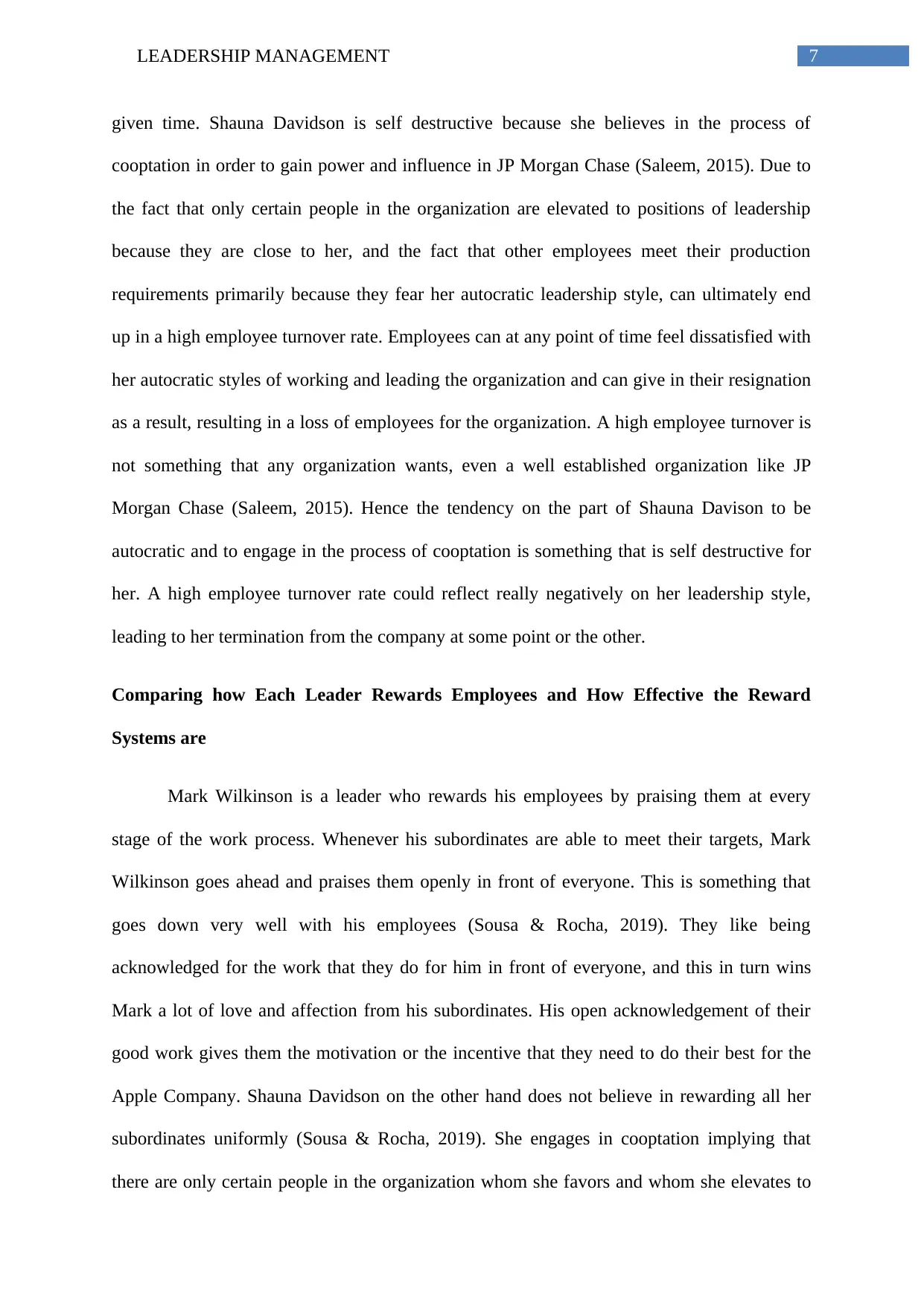
7LEADERSHIP MANAGEMENT
given time. Shauna Davidson is self destructive because she believes in the process of
cooptation in order to gain power and influence in JP Morgan Chase (Saleem, 2015). Due to
the fact that only certain people in the organization are elevated to positions of leadership
because they are close to her, and the fact that other employees meet their production
requirements primarily because they fear her autocratic leadership style, can ultimately end
up in a high employee turnover rate. Employees can at any point of time feel dissatisfied with
her autocratic styles of working and leading the organization and can give in their resignation
as a result, resulting in a loss of employees for the organization. A high employee turnover is
not something that any organization wants, even a well established organization like JP
Morgan Chase (Saleem, 2015). Hence the tendency on the part of Shauna Davison to be
autocratic and to engage in the process of cooptation is something that is self destructive for
her. A high employee turnover rate could reflect really negatively on her leadership style,
leading to her termination from the company at some point or the other.
Comparing how Each Leader Rewards Employees and How Effective the Reward
Systems are
Mark Wilkinson is a leader who rewards his employees by praising them at every
stage of the work process. Whenever his subordinates are able to meet their targets, Mark
Wilkinson goes ahead and praises them openly in front of everyone. This is something that
goes down very well with his employees (Sousa & Rocha, 2019). They like being
acknowledged for the work that they do for him in front of everyone, and this in turn wins
Mark a lot of love and affection from his subordinates. His open acknowledgement of their
good work gives them the motivation or the incentive that they need to do their best for the
Apple Company. Shauna Davidson on the other hand does not believe in rewarding all her
subordinates uniformly (Sousa & Rocha, 2019). She engages in cooptation implying that
there are only certain people in the organization whom she favors and whom she elevates to
given time. Shauna Davidson is self destructive because she believes in the process of
cooptation in order to gain power and influence in JP Morgan Chase (Saleem, 2015). Due to
the fact that only certain people in the organization are elevated to positions of leadership
because they are close to her, and the fact that other employees meet their production
requirements primarily because they fear her autocratic leadership style, can ultimately end
up in a high employee turnover rate. Employees can at any point of time feel dissatisfied with
her autocratic styles of working and leading the organization and can give in their resignation
as a result, resulting in a loss of employees for the organization. A high employee turnover is
not something that any organization wants, even a well established organization like JP
Morgan Chase (Saleem, 2015). Hence the tendency on the part of Shauna Davison to be
autocratic and to engage in the process of cooptation is something that is self destructive for
her. A high employee turnover rate could reflect really negatively on her leadership style,
leading to her termination from the company at some point or the other.
Comparing how Each Leader Rewards Employees and How Effective the Reward
Systems are
Mark Wilkinson is a leader who rewards his employees by praising them at every
stage of the work process. Whenever his subordinates are able to meet their targets, Mark
Wilkinson goes ahead and praises them openly in front of everyone. This is something that
goes down very well with his employees (Sousa & Rocha, 2019). They like being
acknowledged for the work that they do for him in front of everyone, and this in turn wins
Mark a lot of love and affection from his subordinates. His open acknowledgement of their
good work gives them the motivation or the incentive that they need to do their best for the
Apple Company. Shauna Davidson on the other hand does not believe in rewarding all her
subordinates uniformly (Sousa & Rocha, 2019). She engages in cooptation implying that
there are only certain people in the organization whom she favors and whom she elevates to
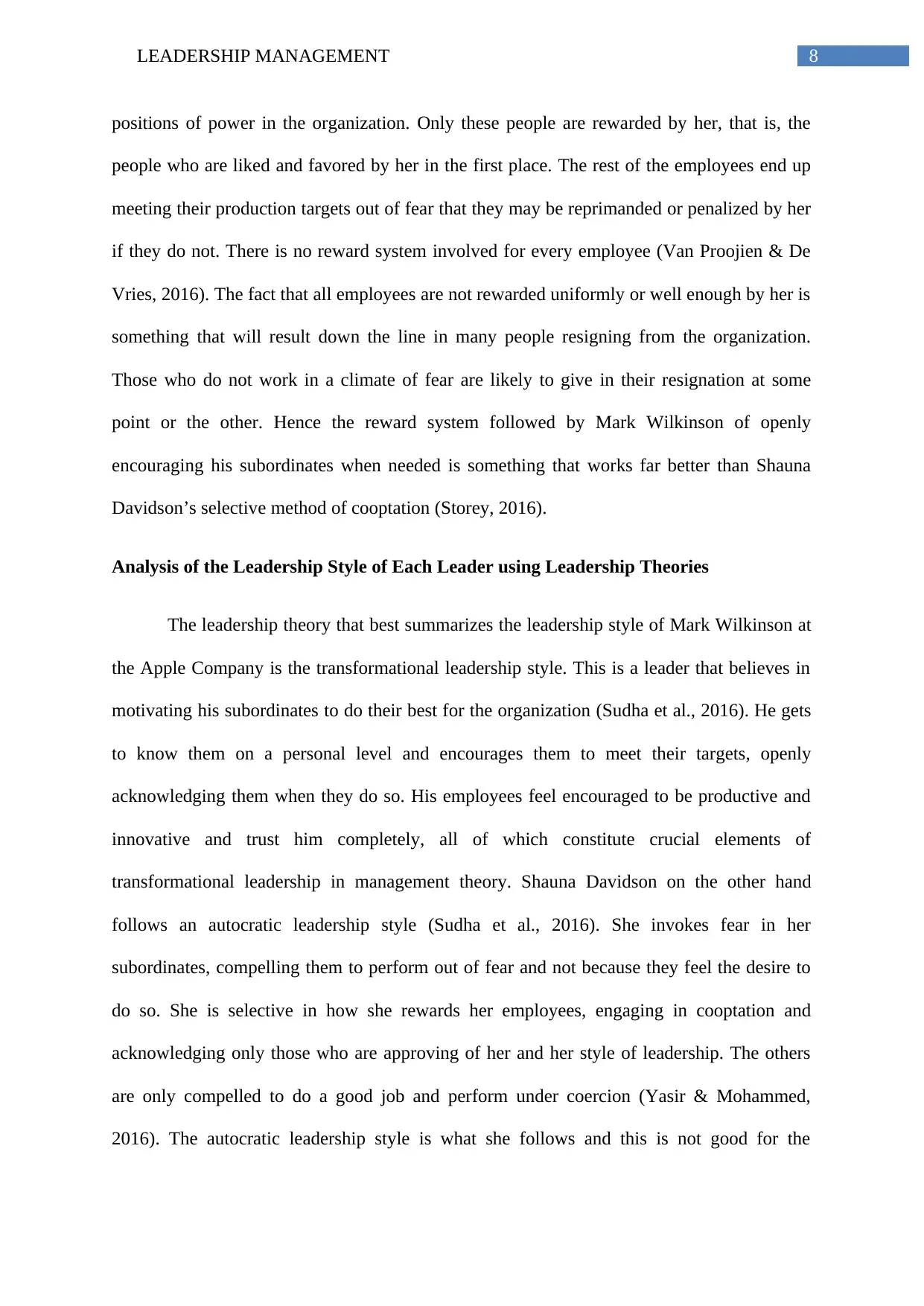
8LEADERSHIP MANAGEMENT
positions of power in the organization. Only these people are rewarded by her, that is, the
people who are liked and favored by her in the first place. The rest of the employees end up
meeting their production targets out of fear that they may be reprimanded or penalized by her
if they do not. There is no reward system involved for every employee (Van Proojien & De
Vries, 2016). The fact that all employees are not rewarded uniformly or well enough by her is
something that will result down the line in many people resigning from the organization.
Those who do not work in a climate of fear are likely to give in their resignation at some
point or the other. Hence the reward system followed by Mark Wilkinson of openly
encouraging his subordinates when needed is something that works far better than Shauna
Davidson’s selective method of cooptation (Storey, 2016).
Analysis of the Leadership Style of Each Leader using Leadership Theories
The leadership theory that best summarizes the leadership style of Mark Wilkinson at
the Apple Company is the transformational leadership style. This is a leader that believes in
motivating his subordinates to do their best for the organization (Sudha et al., 2016). He gets
to know them on a personal level and encourages them to meet their targets, openly
acknowledging them when they do so. His employees feel encouraged to be productive and
innovative and trust him completely, all of which constitute crucial elements of
transformational leadership in management theory. Shauna Davidson on the other hand
follows an autocratic leadership style (Sudha et al., 2016). She invokes fear in her
subordinates, compelling them to perform out of fear and not because they feel the desire to
do so. She is selective in how she rewards her employees, engaging in cooptation and
acknowledging only those who are approving of her and her style of leadership. The others
are only compelled to do a good job and perform under coercion (Yasir & Mohammed,
2016). The autocratic leadership style is what she follows and this is not good for the
positions of power in the organization. Only these people are rewarded by her, that is, the
people who are liked and favored by her in the first place. The rest of the employees end up
meeting their production targets out of fear that they may be reprimanded or penalized by her
if they do not. There is no reward system involved for every employee (Van Proojien & De
Vries, 2016). The fact that all employees are not rewarded uniformly or well enough by her is
something that will result down the line in many people resigning from the organization.
Those who do not work in a climate of fear are likely to give in their resignation at some
point or the other. Hence the reward system followed by Mark Wilkinson of openly
encouraging his subordinates when needed is something that works far better than Shauna
Davidson’s selective method of cooptation (Storey, 2016).
Analysis of the Leadership Style of Each Leader using Leadership Theories
The leadership theory that best summarizes the leadership style of Mark Wilkinson at
the Apple Company is the transformational leadership style. This is a leader that believes in
motivating his subordinates to do their best for the organization (Sudha et al., 2016). He gets
to know them on a personal level and encourages them to meet their targets, openly
acknowledging them when they do so. His employees feel encouraged to be productive and
innovative and trust him completely, all of which constitute crucial elements of
transformational leadership in management theory. Shauna Davidson on the other hand
follows an autocratic leadership style (Sudha et al., 2016). She invokes fear in her
subordinates, compelling them to perform out of fear and not because they feel the desire to
do so. She is selective in how she rewards her employees, engaging in cooptation and
acknowledging only those who are approving of her and her style of leadership. The others
are only compelled to do a good job and perform under coercion (Yasir & Mohammed,
2016). The autocratic leadership style is what she follows and this is not good for the
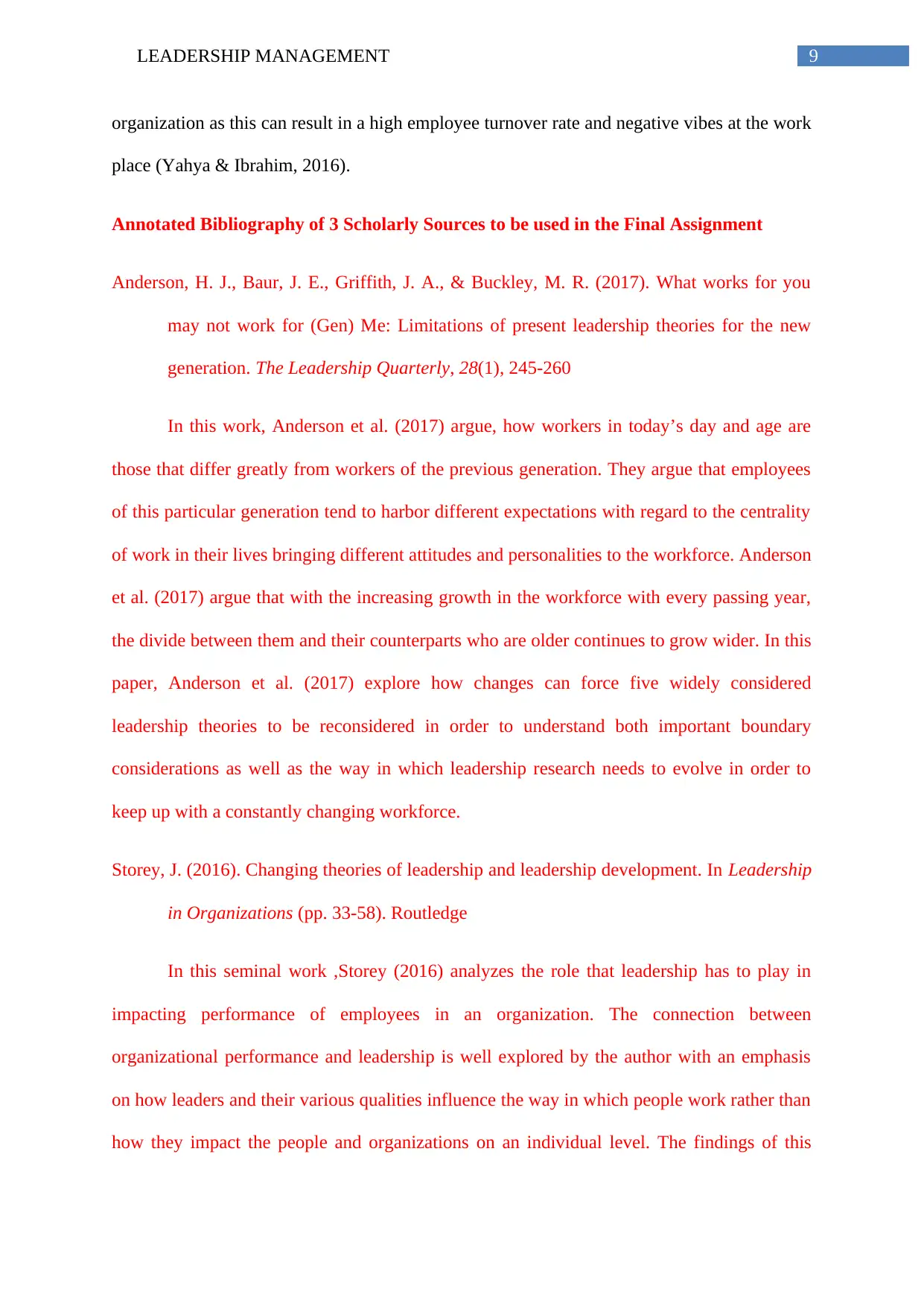
9LEADERSHIP MANAGEMENT
organization as this can result in a high employee turnover rate and negative vibes at the work
place (Yahya & Ibrahim, 2016).
Annotated Bibliography of 3 Scholarly Sources to be used in the Final Assignment
Anderson, H. J., Baur, J. E., Griffith, J. A., & Buckley, M. R. (2017). What works for you
may not work for (Gen) Me: Limitations of present leadership theories for the new
generation. The Leadership Quarterly, 28(1), 245-260
In this work, Anderson et al. (2017) argue, how workers in today’s day and age are
those that differ greatly from workers of the previous generation. They argue that employees
of this particular generation tend to harbor different expectations with regard to the centrality
of work in their lives bringing different attitudes and personalities to the workforce. Anderson
et al. (2017) argue that with the increasing growth in the workforce with every passing year,
the divide between them and their counterparts who are older continues to grow wider. In this
paper, Anderson et al. (2017) explore how changes can force five widely considered
leadership theories to be reconsidered in order to understand both important boundary
considerations as well as the way in which leadership research needs to evolve in order to
keep up with a constantly changing workforce.
Storey, J. (2016). Changing theories of leadership and leadership development. In Leadership
in Organizations (pp. 33-58). Routledge
In this seminal work ,Storey (2016) analyzes the role that leadership has to play in
impacting performance of employees in an organization. The connection between
organizational performance and leadership is well explored by the author with an emphasis
on how leaders and their various qualities influence the way in which people work rather than
how they impact the people and organizations on an individual level. The findings of this
organization as this can result in a high employee turnover rate and negative vibes at the work
place (Yahya & Ibrahim, 2016).
Annotated Bibliography of 3 Scholarly Sources to be used in the Final Assignment
Anderson, H. J., Baur, J. E., Griffith, J. A., & Buckley, M. R. (2017). What works for you
may not work for (Gen) Me: Limitations of present leadership theories for the new
generation. The Leadership Quarterly, 28(1), 245-260
In this work, Anderson et al. (2017) argue, how workers in today’s day and age are
those that differ greatly from workers of the previous generation. They argue that employees
of this particular generation tend to harbor different expectations with regard to the centrality
of work in their lives bringing different attitudes and personalities to the workforce. Anderson
et al. (2017) argue that with the increasing growth in the workforce with every passing year,
the divide between them and their counterparts who are older continues to grow wider. In this
paper, Anderson et al. (2017) explore how changes can force five widely considered
leadership theories to be reconsidered in order to understand both important boundary
considerations as well as the way in which leadership research needs to evolve in order to
keep up with a constantly changing workforce.
Storey, J. (2016). Changing theories of leadership and leadership development. In Leadership
in Organizations (pp. 33-58). Routledge
In this seminal work ,Storey (2016) analyzes the role that leadership has to play in
impacting performance of employees in an organization. The connection between
organizational performance and leadership is well explored by the author with an emphasis
on how leaders and their various qualities influence the way in which people work rather than
how they impact the people and organizations on an individual level. The findings of this
Secure Best Marks with AI Grader
Need help grading? Try our AI Grader for instant feedback on your assignments.
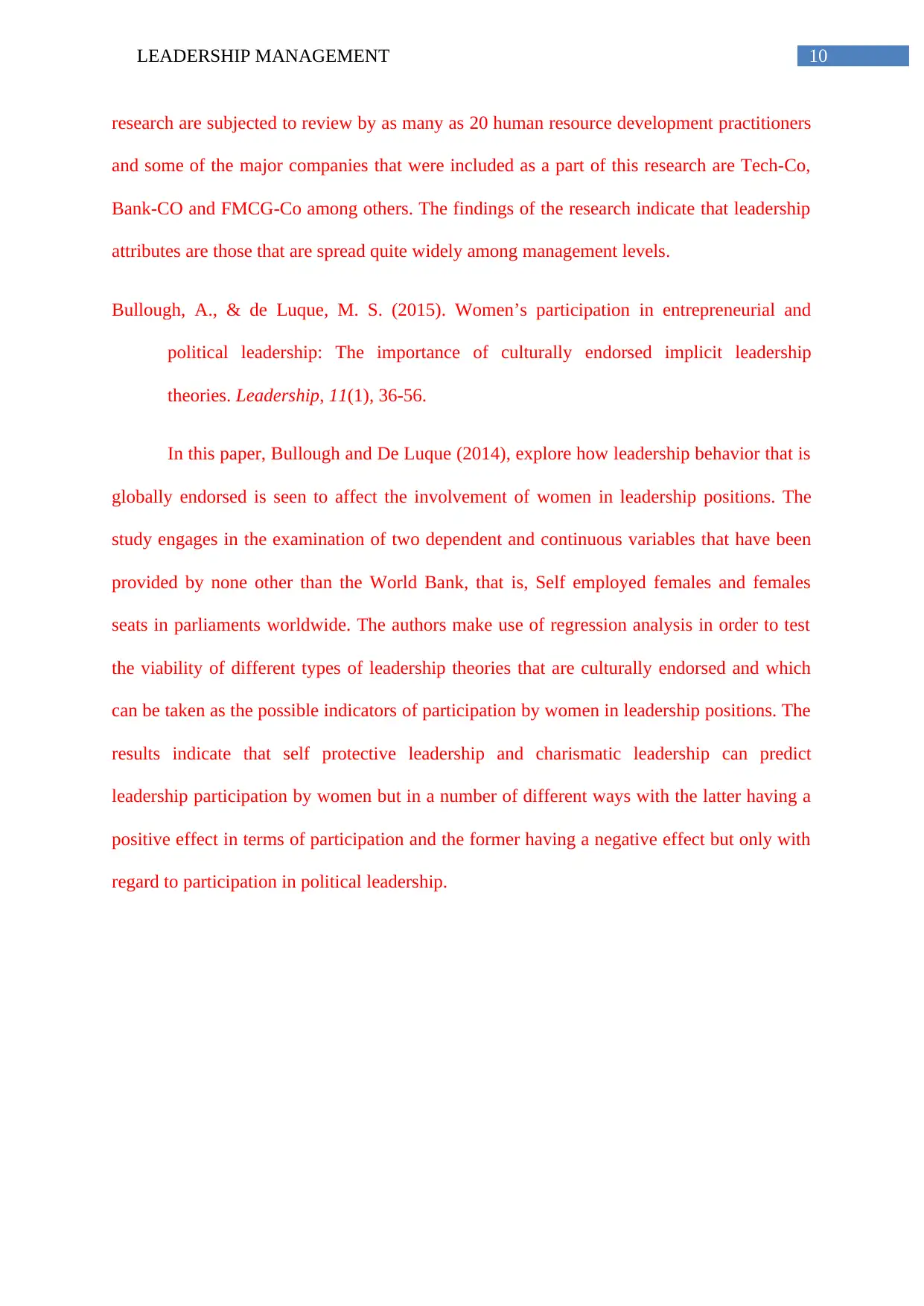
10LEADERSHIP MANAGEMENT
research are subjected to review by as many as 20 human resource development practitioners
and some of the major companies that were included as a part of this research are Tech-Co,
Bank-CO and FMCG-Co among others. The findings of the research indicate that leadership
attributes are those that are spread quite widely among management levels.
Bullough, A., & de Luque, M. S. (2015). Women’s participation in entrepreneurial and
political leadership: The importance of culturally endorsed implicit leadership
theories. Leadership, 11(1), 36-56.
In this paper, Bullough and De Luque (2014), explore how leadership behavior that is
globally endorsed is seen to affect the involvement of women in leadership positions. The
study engages in the examination of two dependent and continuous variables that have been
provided by none other than the World Bank, that is, Self employed females and females
seats in parliaments worldwide. The authors make use of regression analysis in order to test
the viability of different types of leadership theories that are culturally endorsed and which
can be taken as the possible indicators of participation by women in leadership positions. The
results indicate that self protective leadership and charismatic leadership can predict
leadership participation by women but in a number of different ways with the latter having a
positive effect in terms of participation and the former having a negative effect but only with
regard to participation in political leadership.
research are subjected to review by as many as 20 human resource development practitioners
and some of the major companies that were included as a part of this research are Tech-Co,
Bank-CO and FMCG-Co among others. The findings of the research indicate that leadership
attributes are those that are spread quite widely among management levels.
Bullough, A., & de Luque, M. S. (2015). Women’s participation in entrepreneurial and
political leadership: The importance of culturally endorsed implicit leadership
theories. Leadership, 11(1), 36-56.
In this paper, Bullough and De Luque (2014), explore how leadership behavior that is
globally endorsed is seen to affect the involvement of women in leadership positions. The
study engages in the examination of two dependent and continuous variables that have been
provided by none other than the World Bank, that is, Self employed females and females
seats in parliaments worldwide. The authors make use of regression analysis in order to test
the viability of different types of leadership theories that are culturally endorsed and which
can be taken as the possible indicators of participation by women in leadership positions. The
results indicate that self protective leadership and charismatic leadership can predict
leadership participation by women but in a number of different ways with the latter having a
positive effect in terms of participation and the former having a negative effect but only with
regard to participation in political leadership.
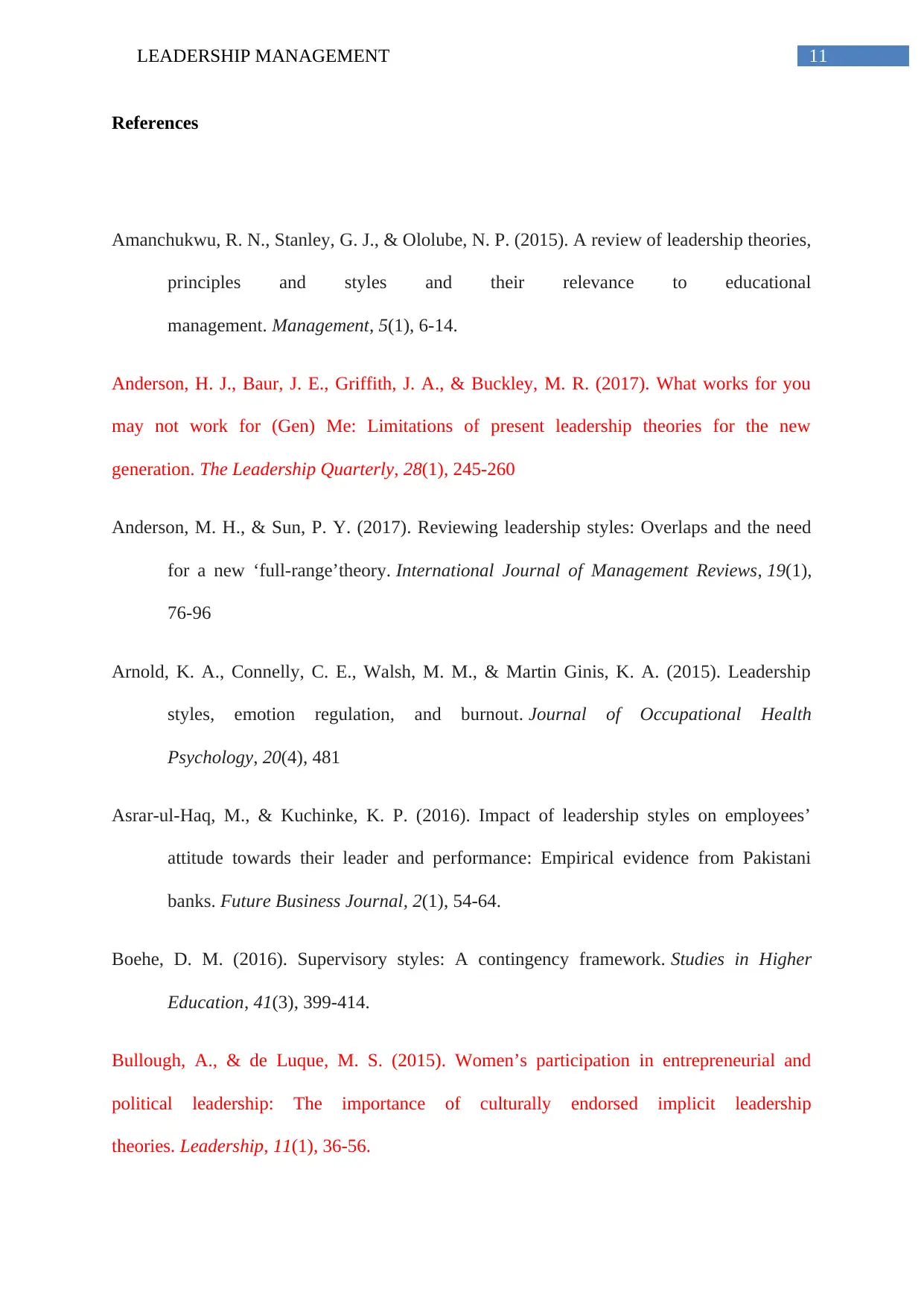
11LEADERSHIP MANAGEMENT
References
Amanchukwu, R. N., Stanley, G. J., & Ololube, N. P. (2015). A review of leadership theories,
principles and styles and their relevance to educational
management. Management, 5(1), 6-14.
Anderson, H. J., Baur, J. E., Griffith, J. A., & Buckley, M. R. (2017). What works for you
may not work for (Gen) Me: Limitations of present leadership theories for the new
generation. The Leadership Quarterly, 28(1), 245-260
Anderson, M. H., & Sun, P. Y. (2017). Reviewing leadership styles: Overlaps and the need
for a new ‘full‐range’theory. International Journal of Management Reviews, 19(1),
76-96
Arnold, K. A., Connelly, C. E., Walsh, M. M., & Martin Ginis, K. A. (2015). Leadership
styles, emotion regulation, and burnout. Journal of Occupational Health
Psychology, 20(4), 481
Asrar-ul-Haq, M., & Kuchinke, K. P. (2016). Impact of leadership styles on employees’
attitude towards their leader and performance: Empirical evidence from Pakistani
banks. Future Business Journal, 2(1), 54-64.
Boehe, D. M. (2016). Supervisory styles: A contingency framework. Studies in Higher
Education, 41(3), 399-414.
Bullough, A., & de Luque, M. S. (2015). Women’s participation in entrepreneurial and
political leadership: The importance of culturally endorsed implicit leadership
theories. Leadership, 11(1), 36-56.
References
Amanchukwu, R. N., Stanley, G. J., & Ololube, N. P. (2015). A review of leadership theories,
principles and styles and their relevance to educational
management. Management, 5(1), 6-14.
Anderson, H. J., Baur, J. E., Griffith, J. A., & Buckley, M. R. (2017). What works for you
may not work for (Gen) Me: Limitations of present leadership theories for the new
generation. The Leadership Quarterly, 28(1), 245-260
Anderson, M. H., & Sun, P. Y. (2017). Reviewing leadership styles: Overlaps and the need
for a new ‘full‐range’theory. International Journal of Management Reviews, 19(1),
76-96
Arnold, K. A., Connelly, C. E., Walsh, M. M., & Martin Ginis, K. A. (2015). Leadership
styles, emotion regulation, and burnout. Journal of Occupational Health
Psychology, 20(4), 481
Asrar-ul-Haq, M., & Kuchinke, K. P. (2016). Impact of leadership styles on employees’
attitude towards their leader and performance: Empirical evidence from Pakistani
banks. Future Business Journal, 2(1), 54-64.
Boehe, D. M. (2016). Supervisory styles: A contingency framework. Studies in Higher
Education, 41(3), 399-414.
Bullough, A., & de Luque, M. S. (2015). Women’s participation in entrepreneurial and
political leadership: The importance of culturally endorsed implicit leadership
theories. Leadership, 11(1), 36-56.
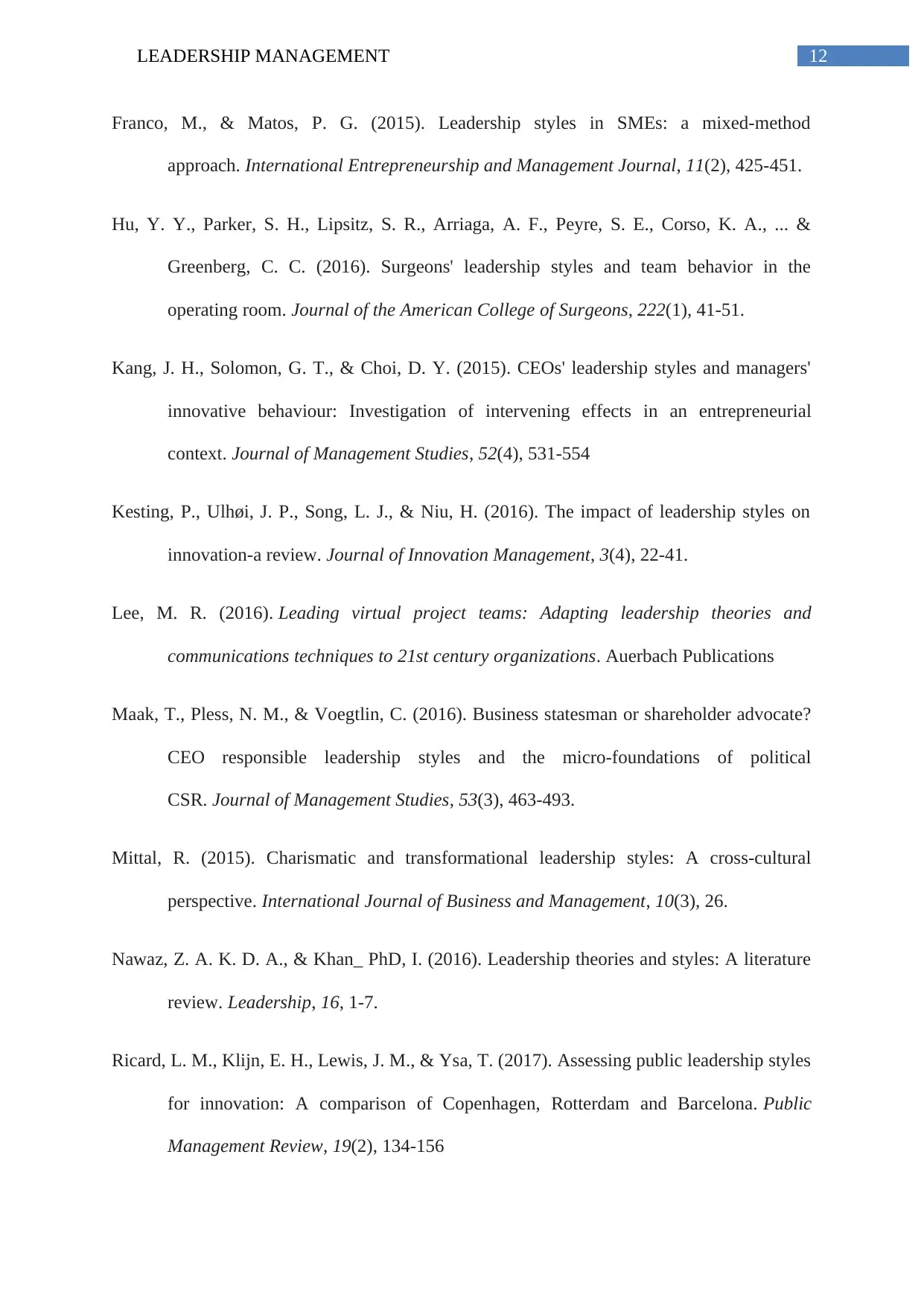
12LEADERSHIP MANAGEMENT
Franco, M., & Matos, P. G. (2015). Leadership styles in SMEs: a mixed-method
approach. International Entrepreneurship and Management Journal, 11(2), 425-451.
Hu, Y. Y., Parker, S. H., Lipsitz, S. R., Arriaga, A. F., Peyre, S. E., Corso, K. A., ... &
Greenberg, C. C. (2016). Surgeons' leadership styles and team behavior in the
operating room. Journal of the American College of Surgeons, 222(1), 41-51.
Kang, J. H., Solomon, G. T., & Choi, D. Y. (2015). CEOs' leadership styles and managers'
innovative behaviour: Investigation of intervening effects in an entrepreneurial
context. Journal of Management Studies, 52(4), 531-554
Kesting, P., Ulhøi, J. P., Song, L. J., & Niu, H. (2016). The impact of leadership styles on
innovation-a review. Journal of Innovation Management, 3(4), 22-41.
Lee, M. R. (2016). Leading virtual project teams: Adapting leadership theories and
communications techniques to 21st century organizations. Auerbach Publications
Maak, T., Pless, N. M., & Voegtlin, C. (2016). Business statesman or shareholder advocate?
CEO responsible leadership styles and the micro‐foundations of political
CSR. Journal of Management Studies, 53(3), 463-493.
Mittal, R. (2015). Charismatic and transformational leadership styles: A cross-cultural
perspective. International Journal of Business and Management, 10(3), 26.
Nawaz, Z. A. K. D. A., & Khan_ PhD, I. (2016). Leadership theories and styles: A literature
review. Leadership, 16, 1-7.
Ricard, L. M., Klijn, E. H., Lewis, J. M., & Ysa, T. (2017). Assessing public leadership styles
for innovation: A comparison of Copenhagen, Rotterdam and Barcelona. Public
Management Review, 19(2), 134-156
Franco, M., & Matos, P. G. (2015). Leadership styles in SMEs: a mixed-method
approach. International Entrepreneurship and Management Journal, 11(2), 425-451.
Hu, Y. Y., Parker, S. H., Lipsitz, S. R., Arriaga, A. F., Peyre, S. E., Corso, K. A., ... &
Greenberg, C. C. (2016). Surgeons' leadership styles and team behavior in the
operating room. Journal of the American College of Surgeons, 222(1), 41-51.
Kang, J. H., Solomon, G. T., & Choi, D. Y. (2015). CEOs' leadership styles and managers'
innovative behaviour: Investigation of intervening effects in an entrepreneurial
context. Journal of Management Studies, 52(4), 531-554
Kesting, P., Ulhøi, J. P., Song, L. J., & Niu, H. (2016). The impact of leadership styles on
innovation-a review. Journal of Innovation Management, 3(4), 22-41.
Lee, M. R. (2016). Leading virtual project teams: Adapting leadership theories and
communications techniques to 21st century organizations. Auerbach Publications
Maak, T., Pless, N. M., & Voegtlin, C. (2016). Business statesman or shareholder advocate?
CEO responsible leadership styles and the micro‐foundations of political
CSR. Journal of Management Studies, 53(3), 463-493.
Mittal, R. (2015). Charismatic and transformational leadership styles: A cross-cultural
perspective. International Journal of Business and Management, 10(3), 26.
Nawaz, Z. A. K. D. A., & Khan_ PhD, I. (2016). Leadership theories and styles: A literature
review. Leadership, 16, 1-7.
Ricard, L. M., Klijn, E. H., Lewis, J. M., & Ysa, T. (2017). Assessing public leadership styles
for innovation: A comparison of Copenhagen, Rotterdam and Barcelona. Public
Management Review, 19(2), 134-156
Paraphrase This Document
Need a fresh take? Get an instant paraphrase of this document with our AI Paraphraser
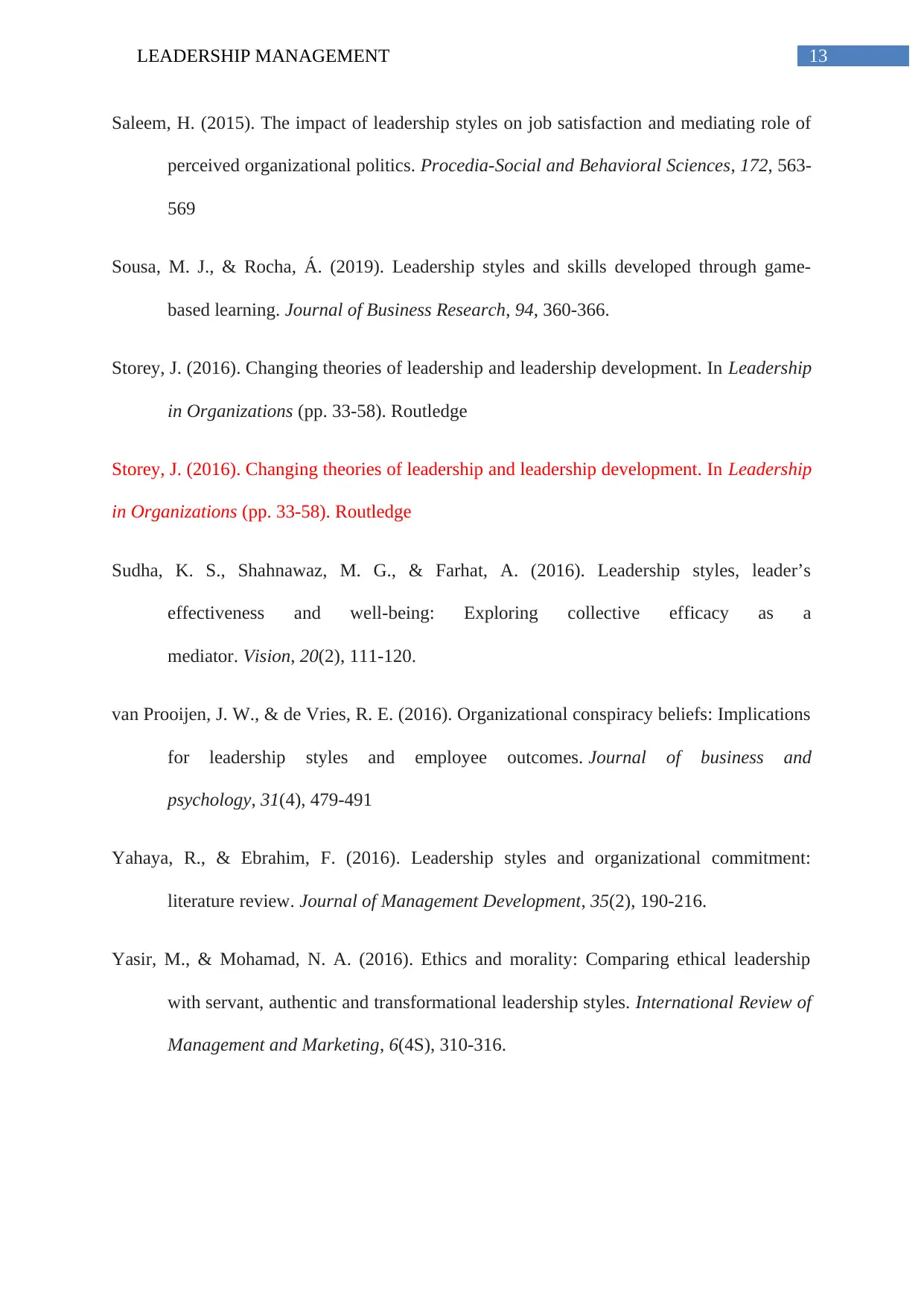
13LEADERSHIP MANAGEMENT
Saleem, H. (2015). The impact of leadership styles on job satisfaction and mediating role of
perceived organizational politics. Procedia-Social and Behavioral Sciences, 172, 563-
569
Sousa, M. J., & Rocha, Á. (2019). Leadership styles and skills developed through game-
based learning. Journal of Business Research, 94, 360-366.
Storey, J. (2016). Changing theories of leadership and leadership development. In Leadership
in Organizations (pp. 33-58). Routledge
Storey, J. (2016). Changing theories of leadership and leadership development. In Leadership
in Organizations (pp. 33-58). Routledge
Sudha, K. S., Shahnawaz, M. G., & Farhat, A. (2016). Leadership styles, leader’s
effectiveness and well-being: Exploring collective efficacy as a
mediator. Vision, 20(2), 111-120.
van Prooijen, J. W., & de Vries, R. E. (2016). Organizational conspiracy beliefs: Implications
for leadership styles and employee outcomes. Journal of business and
psychology, 31(4), 479-491
Yahaya, R., & Ebrahim, F. (2016). Leadership styles and organizational commitment:
literature review. Journal of Management Development, 35(2), 190-216.
Yasir, M., & Mohamad, N. A. (2016). Ethics and morality: Comparing ethical leadership
with servant, authentic and transformational leadership styles. International Review of
Management and Marketing, 6(4S), 310-316.
Saleem, H. (2015). The impact of leadership styles on job satisfaction and mediating role of
perceived organizational politics. Procedia-Social and Behavioral Sciences, 172, 563-
569
Sousa, M. J., & Rocha, Á. (2019). Leadership styles and skills developed through game-
based learning. Journal of Business Research, 94, 360-366.
Storey, J. (2016). Changing theories of leadership and leadership development. In Leadership
in Organizations (pp. 33-58). Routledge
Storey, J. (2016). Changing theories of leadership and leadership development. In Leadership
in Organizations (pp. 33-58). Routledge
Sudha, K. S., Shahnawaz, M. G., & Farhat, A. (2016). Leadership styles, leader’s
effectiveness and well-being: Exploring collective efficacy as a
mediator. Vision, 20(2), 111-120.
van Prooijen, J. W., & de Vries, R. E. (2016). Organizational conspiracy beliefs: Implications
for leadership styles and employee outcomes. Journal of business and
psychology, 31(4), 479-491
Yahaya, R., & Ebrahim, F. (2016). Leadership styles and organizational commitment:
literature review. Journal of Management Development, 35(2), 190-216.
Yasir, M., & Mohamad, N. A. (2016). Ethics and morality: Comparing ethical leadership
with servant, authentic and transformational leadership styles. International Review of
Management and Marketing, 6(4S), 310-316.
1 out of 14
Your All-in-One AI-Powered Toolkit for Academic Success.
+13062052269
info@desklib.com
Available 24*7 on WhatsApp / Email
![[object Object]](/_next/static/media/star-bottom.7253800d.svg)
Unlock your academic potential
© 2024 | Zucol Services PVT LTD | All rights reserved.
